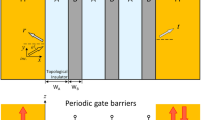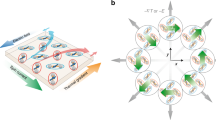Abstract
Electronic devices that use the spin degree of freedom hold unique prospects for future technology. The performance of these ‘spintronic’ devices relies heavily on the efficient transfer of spin polarization across different layers and interfaces. This complex transfer process depends on individual material properties and also, most importantly, on the structural and electronic properties of the interfaces between the different materials and defects that are common to real devices. Knowledge of these factors is especially important for the relatively new field of organic spintronics, where there is a severe lack of suitable experimental techniques that can yield depth-resolved information about the spin polarization of charge carriers within buried layers of real devices. Here, we present a new depth-resolved technique for measuring the spin polarization of current-injected electrons in an organic spin valve and find the temperature dependence of the measured spin diffusion length is correlated with the device magnetoresistance.
This is a preview of subscription content, access via your institution
Access options
Subscribe to this journal
Receive 12 print issues and online access
$259.00 per year
only $21.58 per issue
Buy this article
- Purchase on Springer Link
- Instant access to full article PDF
Prices may be subject to local taxes which are calculated during checkout




Similar content being viewed by others
References
Wolf, S. A. et al. Spintronics: A spin-based electronics vision for the future. Science 294, 1488–1495 (2001).
Xiong, Z. H., Wu, D., Vardeny, Z. V. & Shi, J. Giant magnetoresistance in organic spin-valves. Nature 427, 821–824 (2004).
Pramanik, S. et al. Observation of extremely long spin relaxation times in an organic nanowire spin valve. Nature Nano. 2, 216–219 (2007).
Sanvito, S. & Rocha, A. R. Molecular-spintronics: The art of driving spin through molecules. J. Comput. Theor. Nanosci. 3, 624–642 (2006).
Khaetskii, A. & Nazarov, Y. V. Spin-flip transitions between Zeeman sublevels in semiconductor quantum dots. Phys. Rev. B 63, 184433 (2001).
Cameron, A. R., Riblet, P. & Miller, P. A. Spin gratings and the measurement of electron drift mobility in multiple quantum well semiconductors. Phys. Rev. Lett. 76, 4793–4796 (1996).
Kikkawa, J. M. & Awschalom, D. D. Lateral drag of spin coherence in gallium arsenide. Nature 397, 139–141 (1999).
LaBella, V. et al. Spatially resolved spin-injection probability for gallium arsenide. Science 292, 1518–1521 (2001).
Kotissek, P. et al. Cross-sectional imaging of spin injection into a semiconductor. Nature Phys. 3, 872–877 (2007).
Julliere, M. Tunneling between ferromagnetic films. Phys. Lett. A 54, 225–226 (1975).
Tsukagoshi, K., Alphenaar, B. W. & Ago, H. Coherent transport of electron spin in a ferromagnetically contacted carbon nanotube. Nature 401, 572–574 (1999).
Dediu, V. et al. Room temperature spin polarized injection in organic semiconductor. Solid State Commun. 122, 181–184 (2002).
Shim, J. H. et al. Large spin diffusion length in an amorphous organic semiconductor. Phys. Rev. Lett. 100, 226603 (2008).
Wang, F. J., Yang, C. G., Vardeny, Z. V. & Li, X. G. Spin response in organic spin valves based on La2/3Sr1/3MnO3 electrodes. Phys. Rev. B 75, 245324 (2007).
Jiang, J. S., Pearson, J. E. & Bader, S. D. Absence of spin transport in the organic semiconductor Alq3 . Phys. Rev. B 77, 035303 (2008).
Prokscha, T. et al. The new high-intensity surface muon beam μE4 for the generation of low-energy muons at PSI. Physica B 374, 460–462 (2006).
Bakule, P. & Morenzoni, E. Generation and applications of slow polarized muons. Contemp. Phys. 45, 203–225 (2004).
Drew, A. et al. Coexistence and coupling of superconductivity and magnetism in thin film structures. Phys. Rev. Lett. 95, 197201 (2005).
Suter, A. et al. Direct observation of nonlocal effects in a superconductor. Phys. Rev. Lett. 92, 087001 (2004).
Yunus, M. et al. Ambipolar electrical spin injection and spin transport in organic semiconductors. J. Appl. Phys. 103, 103714 (2008).
Tang, C. W. & VanSlyke, S. A. Organic electroluminescent diodes. Appl. Phys. Lett. 51, 913–915 (1987).
Demonkritov, S. et al. Magnetic-dipole mechanism for biquadratic interlayer coupling. Phys. Rev. B 49, 720–723 (1994).
Altbir, D., Kiwi, M., Ramirez, R. & Schuller, I. K. Dipolar interaction and its interplay with interface roughness. J. Magn. Magn. Mater. 149, L246–L250 (1995).
Park, J. H. et al. Magnetic properties at surface boundary of a half-metallic ferromagnet La0.7Sr0.3MnO3 . Phys. Rev. Lett. 81, 1953–1956 (1998).
Tsymbal, E. Y., Mryasov, O. N. & LeClair, P. R. Spin-dependent tunnelling in magnetic tunnel junctions. J. Phys. Condens. Matter 15, R109–142 (2003).
Malliaras, G. G, Shen, Y., Dunlap, D. H., Murata, H. & Kafafi, Z. H. Nondispersive electron transport in Alq3 . Appl. Phys. Lett. 79, 2582–2582 (2001).
Bässler, H. Charge transport in organic photoconductors. Phys. Status Solidi B 175, 15–56 (1993).
Cölle, M., Gärditz, C. & Braun, M. The triplet state in tris-(8-hydroxyquinoline)aluminium. J. Appl. Phys. 96, 6133–6141 (2004).
Grecu, M. N., Mirea, A., Ghica, C., Cölle, M. & Schwoerer, M. Paramagnetic defect centres in crystalline Alq3 . J. Phys. Condens. Matter 17, 6271–6283 (2005).
Prokscha, T. et al. The new μE4 beam at PSI: A hybrid-type large acceptance channel for the generation of a high intensity surface-muon beam. Nucl. Instrum. Methods A 595,317–331 (2008).
Prokscha, T. et al. <http://lmu.web.psi.ch/lem/index.html>.
Morenzoni, E. et al. Generation of very slow polarized positive muons. Phys. Rev. Lett. 72, 2793–2796 (1994).
Morenzoni, E. et al. Implantation studies of keV positive muons in thin metallic layers. Nucl. Instrum. Methods B 192, 254–266 (2002).
Acknowledgements
We acknowledge financial support from the Schweizer Nationalfonds (SNF) Nos 200021-111690 and 200020-119784 and the NCCR Materials with Novel Electronic Properties (MaNEP) programme. Experiments were carried out at the Swiss Muon Source, Paul Scherrer Institute, Villigen, Switzerland.
Author information
Authors and Affiliations
Contributions
A.J.D. was responsible for project planning. A.J.D, J.H., L.S., F.L.P., A.S., N.A.M., V.K.M., A.D., K.W.K., H.B., R.S., G.J.N., T.P. and E.M. were responsible for the experimental measurements. A.J.D., J.H., L.S., F.L.P., A.S., T.K., W.P.G. and C.B. were responsible for the analysis and interpretation. A.J.D., P.D., P.S., T.K. and W.P.G. were responsible for the sample growth and characterization. The bespoke floating current source was designed, built and tested by A.J.D., A.S. and F.B.
Corresponding author
Supplementary information
Supplementary Information
Supplementary Information (PDF 1856 kb)
Rights and permissions
About this article
Cite this article
Drew, A., Hoppler, J., Schulz, L. et al. Direct measurement of the electronic spin diffusion length in a fully functional organic spin valve by low-energy muon spin rotation. Nature Mater 8, 109–114 (2009). https://doi.org/10.1038/nmat2333
Received:
Accepted:
Published:
Issue Date:
DOI: https://doi.org/10.1038/nmat2333
This article is cited by
-
Muon spin spectroscopy
Nature Reviews Methods Primers (2022)
-
Complete polarization of electronic spins in OLEDs
Nature Communications (2021)
-
Spin injection and transport in single-crystalline organic spin valves based on TIPS-pentacene
Science China Materials (2021)
-
Achieving large and nonvolatile tunable magnetoresistance in organic spin valves using electronic phase separated manganites
Nature Communications (2019)
-
Evidence for the homogeneous ferromagnetic phase in (Ga,Mn)(Bi,As) epitaxial layers from muon spin relaxation spectroscopy
Scientific Reports (2019)



